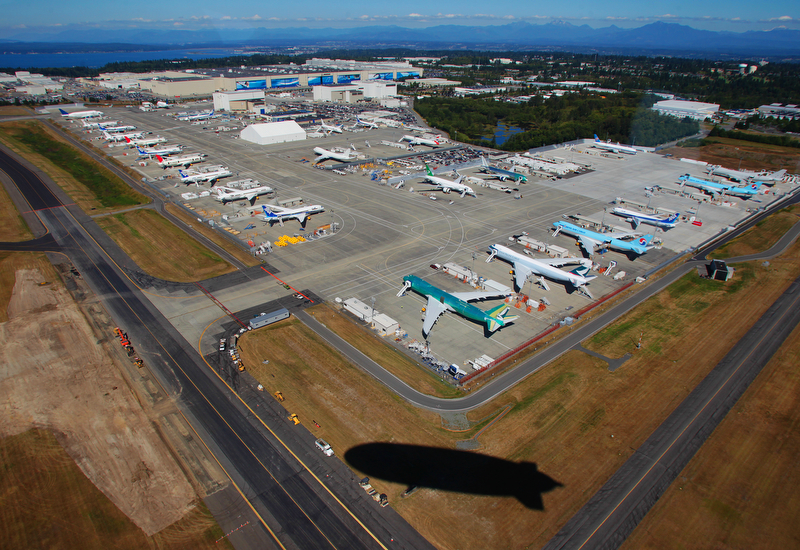Up through the atmosphere
I had a really random week at the end of August consisting of extremes of air and water. The week started with a ride in a Zeppelin. Not a blimp, a zeppelin. They were very insistent that a zeppelin is not a blimp. 
The view south from the Eureka, one of only two Zeppelins flying anywhere in the world, Monday afternoon over Whidbey Island. The Farmers Airship will be flying sight-seeing trips over Seattle through the weekend from Paine Field in Everett.
A day or so later, with the help of Annie, a Lake Stevens police officer and police boat, a real wide lens, and a FISH TANK, I found myself on Lake Stevens photographing an invasive, underwater weed called milfoil.
Portions of Lake Stevens have been taken over by Eurasian watermilfoil, an invasive aquatic weed that mucks up watercraft motors and interferes with swimming. The weed is now part of at least 136 acres of the roughly 1,100 acre lake, according to Mick Monken, public works director of Lake Stevens.
And finally Friday, which found me getting to hop into a Waco UPF-7 biplane to preview a story about an aviation museum we have here in the county.
And just in the interest of full-disclosure, the image below is actually a panoramic image stitched together from a rapid burst of consecutive frames. We ran it as such in the paper with the explanation below. I'd never really violated the single frame like that before, but when I got up there, I just didn't have a wide-enough lens to capture what it felt like up there between those wings. So I shot a lot of images panning wing-tip to wing-tip with the below picture in mind but also shot a ton of just single shot photos.
Unfortunately a 17mm on a Canon 1D type camera just doesn't show a lot in that situation. I wish I had had the 5D and 14mm that I'd used for the fishtank photo of the milfoil above. Let me know if you have any opinions about that sort of stitching technique. Not something I'll probably do again, but it did capture what I saw, so ... argh.
With the Boeing Factory and Paine Field to the right and the Mukilteo ferry terminal directly behind him, Pilot Carter Teeters flys a Waco UPF-7 biplane south over the Puget Sound Friday afternoon. This panoramic image is composed by merging a series of consecutive pictures shot in a rapid burst while the camera was panned from wing-tip to wing-tip. This Waco UPF-7, which began training pilots in 1941 who would go on to fly in World War II and the Korean War, belongs to the Historic Flight Museum at Paine Field.
4 comments:
Gorgeous. Super jealous. Great stitch job; I have no problem with an adequately footnoted panorama.
Discussion topic: my phone now takes HDR images; it brackets 3 exposures in quick succession, and then uses the extra frames to recover highlight and shadow detail. All in one push of the button, automatically. When big cameras start to have that technology, does it still count as one "picture"? Will it need to be footnoted?
Rob, that's a pretty good question. Fred Ritchen's blog (and I guess his book - which he mentions A LOT on his blog - no doubt for good reason) talks a lot about the possibilities for adding greater context for photos by embedding digital content that the reader can access on the photo. He argues that we could really increase our credibility by utilizing the digital technology to really let people in on the process.
http://www.pixelpress.org/afterphotography/?s=digital+manipulation&searchsubmit=Search
Also, the new issue of PDN has an article this month about HDR. I don't have much of an opinion on the ethics of HDR yet, mainly because I don't take it too seriously because all of the HDR photography I see is, well, to put it bluntly, over the top and sort of ugly and horrific and crazy and ridiculous. :)
See:
http://www.flickr.com/photos/kyletucker95/4590423867/in/pool-hdr/
barf
Yeah, no kidding. So much of it is barf.
I think HDR photography is like toupees. When they're over the top, they're super noticeable, and comically awful. When they're done well, they enhance one's image, and you don't even know they're there.
There's definitely room for technology that will extend the dynamic range of digital photography, to keep highlights and shadows from collapsing into 255's and 0's. The problem is that when that range is somehow captured (multiple exposures, for example) then you have to display it. Just because you've got 10 stops of range in your HDR file doesn't magically mean you have the capacity of expressing those 10 stops on a screen or in print. Once someone invents HDR paper (or an HDR monitor that costs less than a toyota camry), I'll be more fully on board.
After all, our own human eyes are super high dynamic range, so it's not as though HDR images are fundamentally fraudulent. If anything, they're _more_ faithful to how the scene "really looked" to the photographer, since the photographer didn't have to decide to see only the highlights or only the shadows.
Oh get off your "photographic integrity" high horse, Mulligan. You stitched together a photo that captured the feeling you experienced better than the camera could have. That's called impressionism.
I'm being facetious, but I really do feel that the camera and the computer are just tools a photographer has available to him in order to create tone/feeling. And since you've been brought up from an in-camera background, I would say that you personally are not really in danger of using short-cuts. Good image-making is good image-making, and a trained eye can tell when something is done with care and when it is sloppy. I think as long as you continue to question the appropriate method, you're fine.
Nice shot :)
Post a Comment